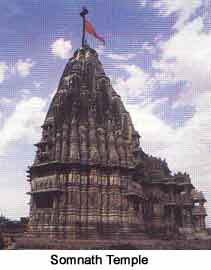

 |  |
 Ghazni, a principality in Afghanistan, came into prominence in 977 when a Turkish nobleman annexed adjoining parts of central Asia and the Trans-Indus regions of the Shahiya kingdom. Twenty-one years later his son Mahmud decided to make Ghazni a formidable power in the politics of central Asia. Mahmud's interest in India was based on the proverbial wealth of the country and the fertility of the Punjab plains, which appeared even more rich and lush from the barren mountains of the Hindu Kush. These campaigns were almost an annual feature for Mahmud. In A.D. 1000 he defeated Jayapala the Shahiya king. The following year he was campaigning in Seistan. The years 1004-6 saw repeated attacks on Multan, a town of strategic importance since it gave control of the lower Indus river. In 1005 Mahmud attacked the Punjab once more and returned home with a vast amount of wealth. The following year he was involved in a conflict with the ruler of Ghur (the area between Ghazni and Herat in Afghanistan). Soon his campaigns led to the arrival of the Afghan armies in India during the harvest.
Ghazni, a principality in Afghanistan, came into prominence in 977 when a Turkish nobleman annexed adjoining parts of central Asia and the Trans-Indus regions of the Shahiya kingdom. Twenty-one years later his son Mahmud decided to make Ghazni a formidable power in the politics of central Asia. Mahmud's interest in India was based on the proverbial wealth of the country and the fertility of the Punjab plains, which appeared even more rich and lush from the barren mountains of the Hindu Kush. These campaigns were almost an annual feature for Mahmud. In A.D. 1000 he defeated Jayapala the Shahiya king. The following year he was campaigning in Seistan. The years 1004-6 saw repeated attacks on Multan, a town of strategic importance since it gave control of the lower Indus river. In 1005 Mahmud attacked the Punjab once more and returned home with a vast amount of wealth. The following year he was involved in a conflict with the ruler of Ghur (the area between Ghazni and Herat in Afghanistan). Soon his campaigns led to the arrival of the Afghan armies in India during the harvest. Temples were depositories of vast quantities of wealth, in cash, golden images, and jewellery - the donations of the pious and these made them natural targets for a non-Hindu searching for wealth in northern India. Mahmud's greed for gold was insatiable. From 1010 to 1026 A.D. the invasions of Mahmud were directed to temple towns - Mathura, Thanesar, Kanauj, and finally Somnath. The concentration of wealth at Somnath was renowned, and consequently it was inevitable that Mahmud would attack it. Added to the desire for wealth was the religious motivation, forceful conversions being a meritorious activity among the more orthodox followers of the Islamic faith. The destruction at Somnath was frenzied, and its effects were to remain for many centuries in the Hindu mind and to colour its assessment of the character of Mahmud, and of Muslims in general. Mahmud died in 1030 to the relief of the people of northern India, who had come to associate his name with annual raids and idol breaking. From his campaign in Khvarazm Mahmud brought back with him a scholar by the name of Alberuni, perhaps the finest intellect of central Asia, and who spent ten years in India at the order of Mahmud. Alberuni's work on. India Tahqiq-i-Hind contains observations on Indian civilization Which are remarkably incisive and acute. next page >> |
Copyright ©2000 indiansaga.info. All rights reserved.
By using this service, you accept that you won't copy or use the data given in this website for any commercial purpose.
The material on indiansaga.info is for informational & educational purpose only.
This site is best viewed at 800 X 600 picture resolution.